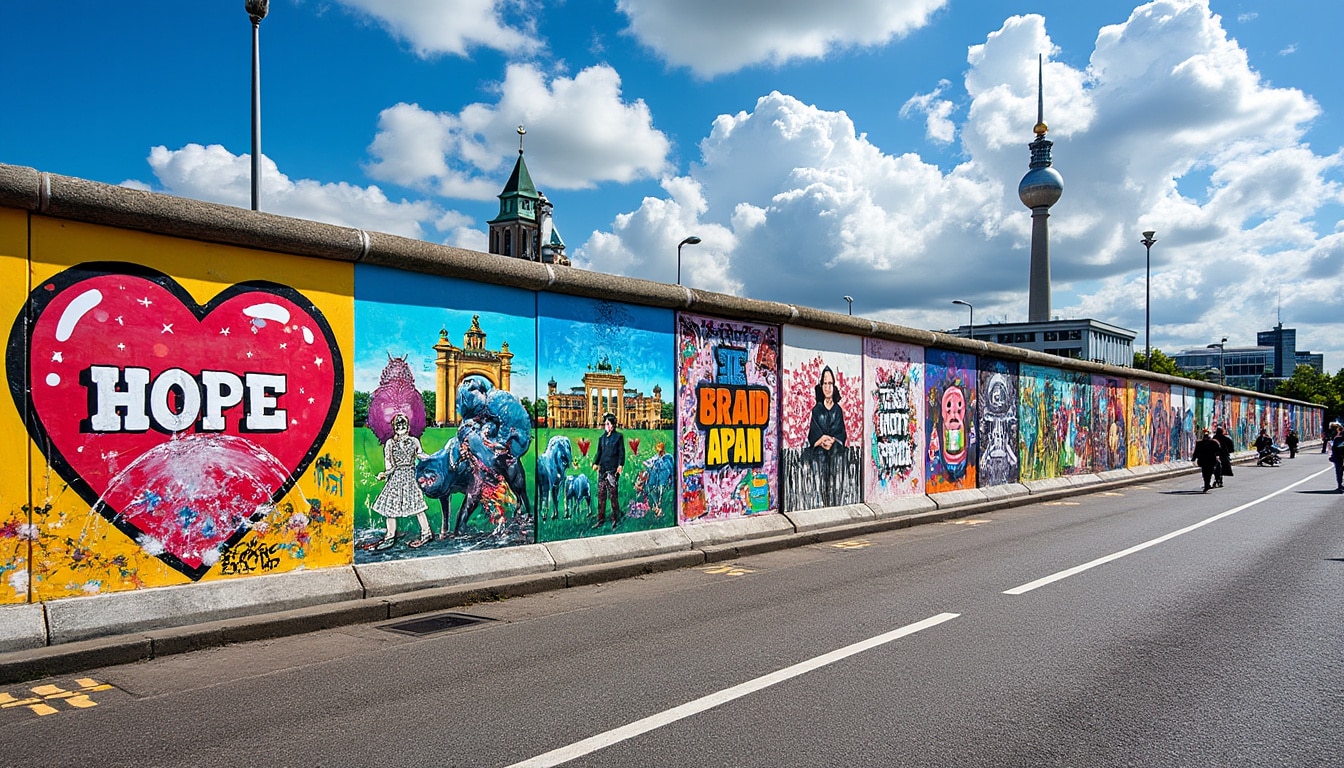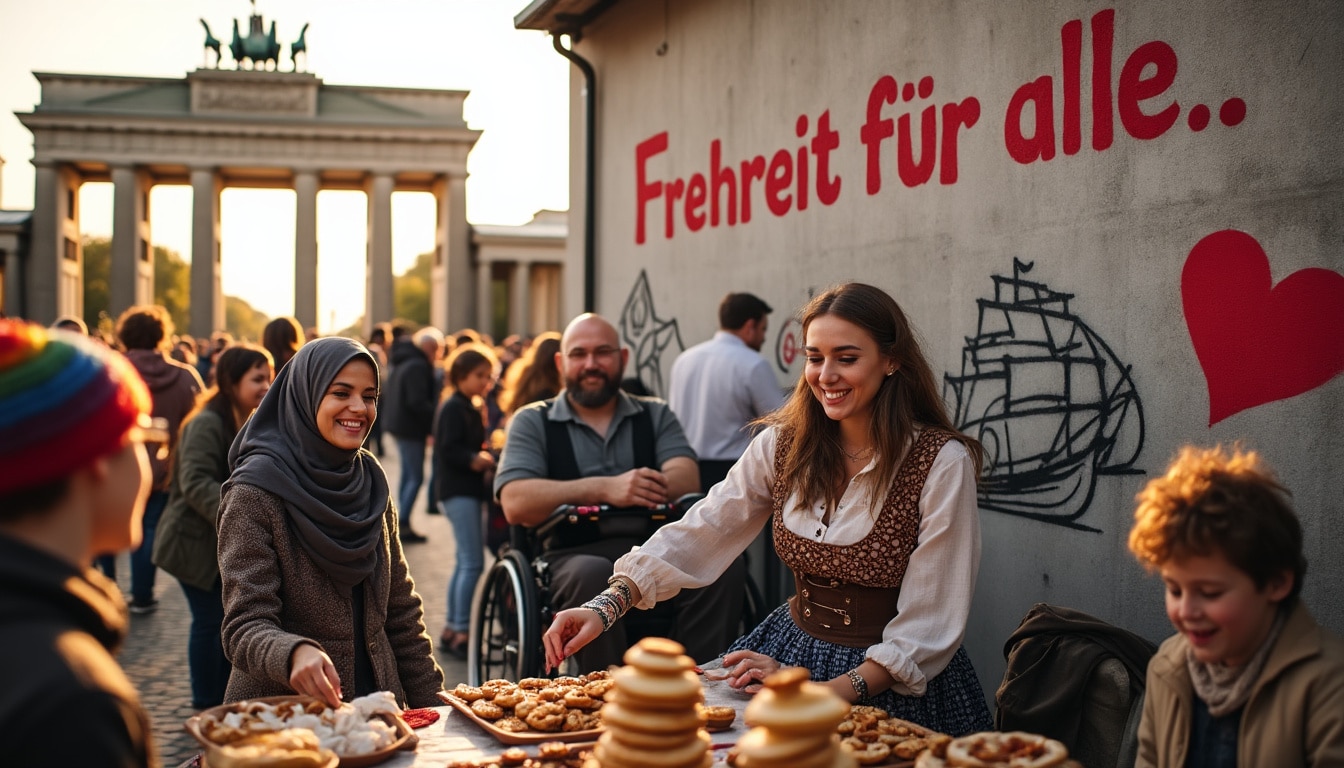Berlin, the eclectic heart of Germany, pulsates with vibrant energy, drawing travelers and culture enthusiasts from around the globe. While its rich history and monumental landmarks often steal the spotlight, the city is peppered with quirky and intriguing facts that paint a fuller picture of its character. Not merely a backdrop for historical feats, Berlin unfolds layers of cultural tales and social intricacies—offering more than meets the eye. Journey through Berlin’s lesser-known facets, from its expansive urban stretches to its bustling Späti culture, and uncover the offbeat narratives that define this iconic metropolis.
Berlin’s Evolution: From War-Torn City to Cultural Wonderland
Berlin’s transformation over the decades is nothing short of impressive. Once fragmented by Cold War tensions, it has blossomed into a haven for creativity and cultural exploration. A prominent highlight that speaks volumes of this evolution is the iconic East Side Gallery. Standing as the largest open-air gallery in the world, the East Side Gallery memorializes the Berlin Wall, once a divisive barrier. Painted immediately after the wall’s fall in 1990, it now showcases 106 artworks by artists from 21 countries. Among these, the thought-provoking ‘Fraternal Kiss’ mural is particularly famous—it symbolizes a blend of contentious history and artistic fervor.
But Berlin isn’t just about historical remnants—its cultural scene is equally compelling. The city houses more than 190 museums and galleries, surpassing the number of annual rainy days, which are fewer in comparison. This abundance means there is always an opportunity to delve into themes ranging from ancient history to futuristic modern art. The Museum Island is one of Berlin’s three UNESCO World Heritage Sites, hosting an array of treasures from the ancient world.

The Open Cultural Spaces of Berlin
What truly makes Berlin unique is the seamless integration of its open spaces into the cultural fabric of the city. The expanse of waterways cutting through Berlin—spanning approximately 180 kilometers—paints a picturesque scene of urban and natural collaboration. In fact, this makes Berlin not just a city of bricks and mortar but also of serene waterway escapes, surpassing the networks of Venice and Amsterdam. While Amsterdam may boast more bridges, Berlin’s noteworthy 1,700 bridges interlace the city with aesthetic charm and functional crossings.
The expansiveness of Berlin cannot be overstated. Covering an area of 892 square kilometers, it is nearly nine times the size of Paris. Yet, despite its vastness, the city maintains a cozy feel, thanks to a lower density of about 4,000 inhabitants per square kilometer, offering open streets and breathing spaces.
For those exploring Berlin’s outdoor allure, the parks and green expanses offer a sanctuary away from the urban rush, contributing to over 44% of the city’s green belt. Urban Legends Berlin and Berlin Insight narratives often shine a light on these quiet, less frequented spots where history and nature coexist.
Social Dynamics: Berlin’s Personality Through Its People
Understanding Berlin requires delving into the social dynamics that define its populace. The city holds a reputation as Germany’s singles capital, reflecting its open-minded and independent spirit. As of 2015, studies showed one in two Berliners were single or unmarried, celebrating a lifestyle defined by freedom and exploration. While a traditional relationship model might take a backseat, the city thrives on a collective of diverse individuals shaping its cultural narratives.
Interestingly, this vibrant social tapestry is mirrored by the presence of over 1,000 ‘Spätis’ or late-night stores. Historically catering to nightshift workers, these kiosks have evolved into a crucial part of Berlin’s urban lifestyle—offering everything from snacks to essentials around the clock. Spätis encapsulate the ethos of Berlin’s night-time hustle and bring to life the city’s round-the-clock dynamism.
The Phenomenon of Civic Voices Berlin
It’s fascinating to observe how Berlin’s social narratives manifest through its civic voices. From prolific street artists to influential grassroots movements, the city echoes with expression at every turn. Street art in Berlin is not merely decorative—it serves as a vibrant form of commentary, often revealing underlying socio-political themes through bold imagery and captivating murals.
Graffiti in Berlin, while at times controversial, is a vital component of its identity. In districts like Kreuzberg and Prenzlauer Berg, the colorful art sprawls are constant conversations with locals and tourists alike, symbolizing both personal and communal stories. Civic art initiatives continue to legalize and encourage these displays, blending public and creative spaces ingeniously.
- 🎨 Street art tours are available for enthusiasts looking to understand the stories behind the walls.
- 🚸 Look for the historical Graffiti Museum in Berlin for curated insights into the art form’s evolution.
Architectural Wonders and Urban Development
In an era where modernity mingles with historical architecture, Berlin stands as a testament to innovative urban development. Among its architectural crown jewels is the Berliner Fernsehturm (TV Tower), Germany’s tallest building towering at 368 meters. Offering panoramic city views from its 203-meter high viewing deck, it remains a symbol of Berlin’s post-war modernization efforts.
KaDeWe, Berlin’s expansive department store, is another marvel. With its impressive 60,000 square meters of retail space, KaDeWe offers a stroll through luxury that rivals even the global shopping capitals. With culinary experiences equally as indulgent, it represents the city’s embracing of both consumer culture and historic business districts.
The Unique Identity of Berlin’s Infrastructure
Berlin’s infrastructure is peppered with unique identities, from its beloved Ampelmännchen (little traffic light man) to its vast networks of efficient public transport. This charming character, adopted initially in East Berlin, became a cultural icon, withstanding reunification attempts to replace it.
| 🛑 Icon | 🛣️ Feature | 🌍 Cultural Significance |
|---|---|---|
| Ampelmännchen | Unique traffic light figure | Symbol of East Berlin identity |
| Spätis | Round-the-clock kiosks | Reflects Berlin’s innovative lifestyle |
| Bridges | 1,700 structures | Architectural charm across waterways |
Culinary Tales: A Taste of Berlin
Diving into Berlin’s food scene means savoring diverse tastes from across the globe, yet some dishes distinctly elevate the Berlin experience to a different plane. The famous Döner Kebab, often considered Berlin’s culinary gift, is a favorite street food, served at numerous kiosks and eateries throughout the city. On average, about 950 Döner spits are consumed daily here, solidifying its iconic status in local cuisine.
No culinary journey in Berlin would be complete without tasting the Berliner Weiße—a uniquely sour beer served with a dash of raspberry or woodruff syrup. This beverage is synonymous with summer afternoons in Berlin, enjoyed across beer gardens thriving in the city.
Beyond Döner and Weiße, culinary adventures extend into the realms of fine dining. The famed rooftop restaurant atop the Bundestag building is not only known for its spectacular views but also for seamlessly blending political history with a refined dining experience.
- 🥙 For a gourmet twist, try the high-end Döner Kebab at Hotel Adlon.
- 🍻 Explore Berlin’s beer culture with a focus on local brews beyond the mainstream options.
- 🍴 Don’t forget to book in advance for popular eateries like the Bundestag restaurant.
These unique culinary stories illuminate another facet of Berlin, where tradition meets modern gastronomy, appealing to varied tastes and preferences.
FAQ: Unveiling Berlin’s Hidden Stories
- What makes the East Side Gallery unique?
- How does Berlin balance its historical and modern landmarks?
- What social aspects are most distinctive of Berlin’s culture?
- Why is Berlin considered a city of bridges?
- How does Berlin maintain its unique identity in a globalized world?

